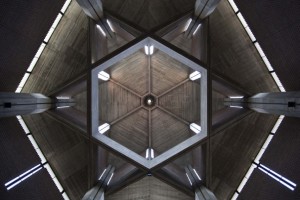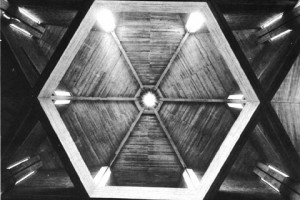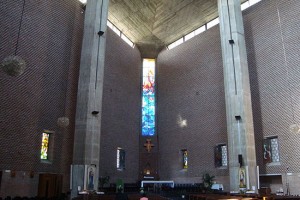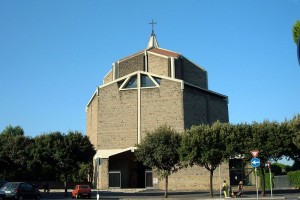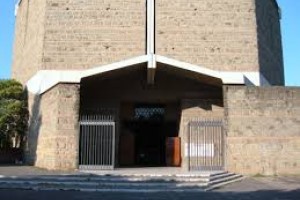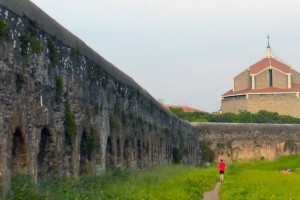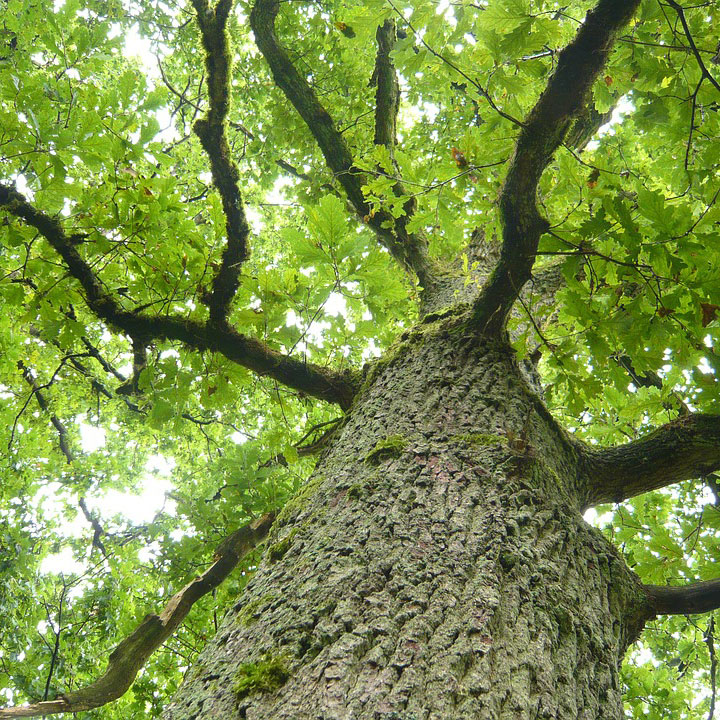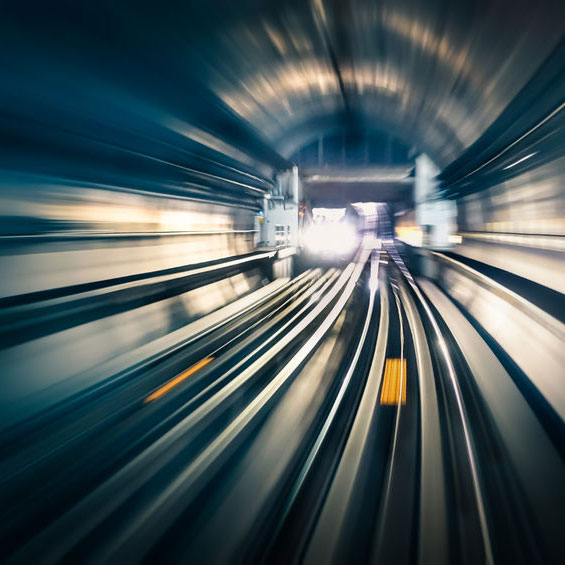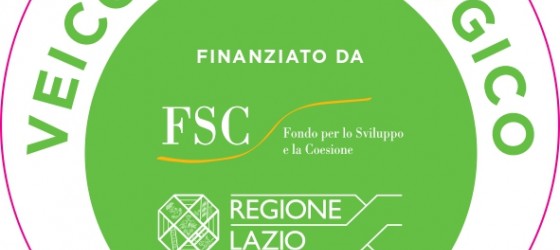San Policarpo Church
Roma, Cinecittà
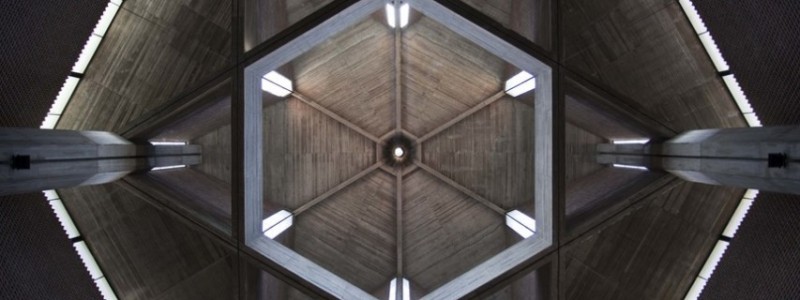
Project Description
The church of St. Polycarp is the architectural symbol of the district Appio Claudio and one of the most significant examples of religious art made in Rome in the sixties. Designed by the renowned Roman architect-engineer Joseph Nicolosi (1901-1981), who in San Policarpo leaves its highest testimony, denounces an external form and internal high and mighty, located on the fringes and closing of the quarter, however, within the fine Aqueducts Park. It develops a "central plan" imbued with symbolic significance, theological and liturgical, showing two different structures: an outer perimeter, a coated self-supporting masonry closing out with peperino square blocks alternating with brick appeals, one internal reinforced concrete to support the roof. Inside the church, six great places to internal hexagon pillars supporting the roof top with the same number of high beams arranged according to the sides of two equilateral triangles entered the hex that intersect, draw a six-pointed star, the Seal of Solomon that expresses the union of heaven and earth, the spiritual world with the material world. The parish was established September 3, 1960, by decree of the Cardinal Vicar Clemente Micara "Paterna solicitude", and entrusted to the diocesan clergy of Rome, in the person of Don Sisto Gualtieri, with subsequent decree of 6 September. In the initial period, during construction of the new church for the liturgical and catechetical activities it was used a local - shop in Viale Appio Claudio 322, central enough why, then, the affected area was not very extensive. At the end of 1961, the parish moved to the premises - street garage Festo Porzio 25. It began to build the new building for the church to the Appian park boundaries, in a territory inferred from that of the Assumption of Mary Parish. The area was a strong housing development and there were then about 8,500 persons, certified by a document of the General Office of Statistics and Census Secretariat, signed by the Special Commissioner. The land for the construction of the church was made available for free by Gerini - Torlonia accounts, with a return to donors in appreciation of the surrounding land. The work took off in July 1964 and October 25 of that year S.E. Msgr. Ettore Cunial laid the foundation stone blessed in St. Peter by the Holy Father Paul VI. The church and the parish halls were inaugurated July 15, 1967 by Cardinal Vicar Luigi Traglia.It was published a remarkable book about this architecture, written by Roberto Luciani, one of the leading historians in Italy, outlining the artistic path of the historic temple. The work will be presented Friday, November 20, 2015 at 18 in Rome in the church of St. Polycarp same in the presence of the parish priest Don Alessandro Zenobbi who had "the wonderful idea to publish for the first time a book on the Church of St. Polycarp which meets the expectations of interpreting the building from the artistic point of view and at the same time to re-tie the threads of the story that the parish was founded in 1960 ". In addition to the author, the book will be illustrated by the Bishop Guerino Di Tora - now pastor of St. Polycarp until 1998 -, the General Manager of the Ministry of Cultural Heritage Francesco Scoppola, by the Dean of the Faculty of Theology of the Pontifical Lateran Nicola Ciola, the art critic and journalist Prof. Mario Dal Bello. During the meeting, moderated by Dr. Stephen's Secret, the actor Luca Martella will read some interesting passages in the book accompanied by Sax Matteo Martella.
Luciani approaches the topic with transportation, ranging in various fields with skill and wisdom, as claimed by the same Ciola: "A special mention also deserves the wise description of the relationship between stones and light inside the building: a light that falls from 'tall, which inevitably invites to look up and sweep, with the eyes of faith, beyond the picture window of the apse, the strict columns and dome bold styling, inside, the star of David: a church - we might say - place in full its primary task of helping the faithful to gather in prayer and look up, much higher than where the limited human eye can allow you to arrive. " The text often becomes poetic, as in this passage where Luciani tackles the theme of light: "The characteristic element of Saint Polycarp Church is the light ... It is a liquid light that flows in and flows upward flows in those areas real or illusory , to illuminate the complexity of the masonry, creating in its wake, different points of view, new focal points. In this action game, the teacher takes the forms to which manages to give the reality and the illusion of plasticity. " Luciani highlights the relationship that Nicolosi very well want to have with the surrounding space, "Nicolosi is in the San Policarpo manufactures a relationship with the past, a different relationship with space. On this space, after the chromatic charm and timeless of all time, he transfers the nature and its inhabitants, which certainly attract him, with functional communication in the strict sense, becoming hypothesis vis other messages: elementary volumes and signs courtly overlap, the gesture inventions are intertwined, current approaches to history, the soft colors of the lava stone and brick that when the rain washes darken them prepare future plastics summary that will appear as a sacrifice for the benefit of the imagination 'evidence, but as a concentrate of architecture-lived nature of dialectics, with the advantage to sow in his spiritual reason a universal light. " The Church of the book object is inserted in the spectacular context of the Park of the Aqueducts, constituting an integral part of the Regional Park of Appia Antica, which takes its name and is characterized by the presence of ancient aqueducts that ensured the water supply of Rome. At this place the author devotes the second part of the book: the area is crossed by seven aqueducts, six classic era (Anio Vetus, Marcio, Tepula, Iulia, Claudio, Anio Novus), dated between the third century. B.C. and the first century. A.D. and a vintage Renaissance (Happy), built and commissioned by Pope Sixtus V (Felice Peretti, 1585-1590). In addition to the Aqueducts, Acqua Mariana Luciani dedicates a space to the Villa of "Vignacce", the Casale di Roma Vecchia and Torre del Tax, buildings that rise between the fields of the Park as magically grown sprouts in another time. Also in the afterword of Ciola same work comes a theological connotation: "I would say that the author is able to translate in his work the unequivocal truth of our Christian faith and that is that the church is realized in a place and at a time. When the history of a place and a time intersect concretely, it is certain that there is a living church that continues to pulsate and to be abreast of the times. Roberto Luciani has the undeniable merit of helping us to understand that the architect Nicolosi design blends in surprisingly consistently with EU projects and designs of the architect of the universe and of human history, the transcendent God who spoke in a particular story that has become universal history and embodied salvation ". The theme of salvation is present in the Parish inscriptions taken from the Dies Irae of Thomas of Celano : Rex tremendae nous , Here salvandos salvas free , save me, fons pietatis ! ( O King of tremendous majesty , you save for your mercy those who are to be saved , save me, O fountain of piety ! )
Climater Interventions
Climater realizes the heating system in service of the Church .Services
Heating system design and realization.
Interval
- Work start
- Data non specificata


